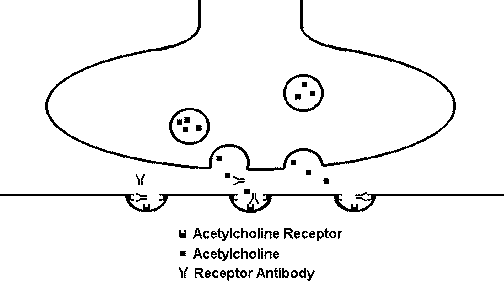Clinical History:
A 33-year-old woman has noted increasing difficulty with her secretarial work as the day progresses, making more mistakes at her computer keyboard and seemingly unable to keep her eyes open to see the computer monitor. She tries getting more sleep each night, but this does not improve her condition. She exhibits progressive weakness and fatigue over the next several months. When seen by her physician, she is noted to have more proximal muscular weakness, particularly with repetitive motion. Deep tendon reflexes are normal. No neurologic deficits are noted. Cranial nerves II - XII are intact. She has normal mental function. There is no muscle pain. Her range of motion in her extremities is normal. No joint pain is present.
The results of electromyography are shown here:

An electromyogram (EMG) is recorded via a needle inserted into a muscle. The pattern shown on the EMG reflects a summation of motor units within range of the needle. With normal muscle contraction, there are many motor units involved, so an individual action potential is not seen, but a summation of many action potentials that produce an interference pattern that appears as triphasic and biphasic discharges, as shown above. The normal duration of these discharges is 5 to 15 milliseconds, with an amplitude from 200 microvolts to 2 millivolts.
A week later she develops respiratory distress and goes to the emergency room. She requires intubation. The blood bank is consulted to arrange for emergent plasmapheresis.
-
- Which of the following laboratory test findings is most likely to be present in this patient?
- A. Positive serology for Lyme disease
- B. Positive acetylcholine receptor antibody
- C. Elevated creatine kinase
- D. Increased cortisol
- E. Monoclonal gammopathy
|
Answer B. In myasthenia gravis, there are antibodies directed against acetylcholine receptors on skeletal muscle. This leads to a decrease in the number of acetylcholine receptors at the post-synaptic muscle membrane. When acetylcholine is released, small end plate potentials result, failing to trigger muscle action potentials. The result is weakness in muscular contraction. In normal muscle, there is typically less acetylcholine released with repeated activity, but the lack of efficient neuromuscular transmission in myasthenia gravis leads to activation of fewer and fewer muscle fibers with repeated nerve impulses. This accounts for the fatigue observed clinically as well as with electromyography.

Further History:
The patient has a chest CT scan performed, and there is a 6 cm mass noted in the anterior mediastinum.
-
- What is this mass most likely to be?
- A. Nodular sclerosis Hodgkin's disease
- B. Small cell anaplastic carcinoma
- C. Tuberculous lymphadenitis
- D. Thymoma
- E. Abscess
|
Answer D. Thymic abnormalities can be seen in about 3/4 of patients with myasthenia gravis. Most of these patients will have thymic hyperplasia and some will have a thymoma. Surgical removal of the thymus will improve the patient's condition.
Further History:
Following surgery for removal of the anterior mediastinal mass, she still remains weak for several years.
-
- Which of the following therapies following surgery is most likely to be effective for this patient over the next several years to treat the underlying problem?
- A. Corticosteroids
- B. Antibiotics
- C. Plasmapheresis
- D. Chemotherapy
- E. Physical therapy
|
Answer A Most myasthenic patients can also be improved symptomatically with use of anticholinesterase medications, and these acetylcholinesterase inhibitors alone are used only in mild ocular disease. Since myasthenia gravis is an autoimmune condition, in the majority of patients immunomodulatory therapy is begun early. Corticosteroids are the most commonly used initial therapy, followed by azathioprine. In refractory cases immunosuppressants such as cyclosporine and cyclophosphamide may be used. Plasmapheresis and intravenous immunoglobulin are employed in the treatment of acute exacerbations and myasthenic crisis. The role of thymectomy in improving long term outcome in nonthymomatous myasthenia gravis remains controversial.
|
|



